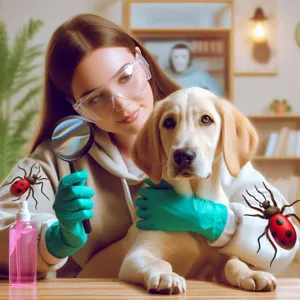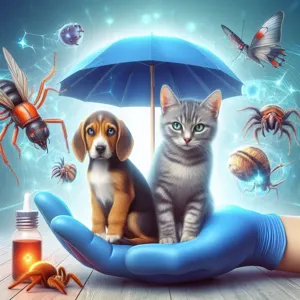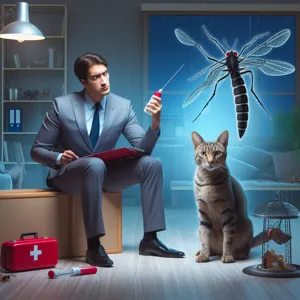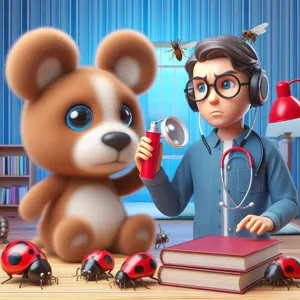As loving pet owners, we strive to provide our furry companions with the safest and healthiest environment possible.
However, lurking in the shadows are pests that can threaten their well-being and disrupt the harmony of our homes. From pesky fleas and ticks to invasive mites and worms, these unwelcome intruders can cause discomfort, disease, and distress for our beloved pets. In this comprehensive guide, we will explore the top strategies to shield your pet from these relentless pests, ensuring their comfort and health year-round. From natural prevention methods and grooming tips to effective treatments and environmental considerations, you’ll discover practical solutions that not only safeguard your pets but also promote a happier, pest-free household. Join us as we delve into the world of pet protection and arm yourself with the knowledge to keep your loyal companions safe from harm.
1. Understanding Common Pet Pests: Types and Risks

When it comes to protecting our furry companions, knowledge is power. Understanding the common pests that threaten pets is the first step in creating a robust defense strategy. The most prevalent offenders include fleas, ticks, and mites, each bringing their own set of risks and challenges.
**Fleas** are perhaps the most notorious of pet pests. These tiny, agile parasites can quickly infest your home, jumping from one pet to another and even finding their way onto humans. Beyond the incessant itching and discomfort they cause, fleas can lead to more serious health issues, such as anemia or allergic reactions. Their life cycle is rapid; a single female flea can lay up to 50 eggs per day, making it crucial to address an infestation swiftly.
**Ticks**, on the other hand, are often found in wooded or grassy areas and can latch onto your pet during outdoor adventures. They are more than just a nuisance; ticks can transmit serious diseases like Lyme disease and Rocky Mountain spotted fever, which can have long-lasting effects on your pet’s health. Regular checks after outdoor excursions are essential in preventing these hitchhikers from making a home on your beloved companion.
**Mites**, though less visible than fleas and ticks, can lead to significant discomfort and health issues in pets. Sarcoptic mites, responsible for scabies, can cause intense itching and skin lesions, while ear mites can lead to painful infections. Both conditions require prompt veterinary attention to alleviate pain and prevent further complications.
By familiarizing yourself with these common pests and the risks they pose, you can take proactive measures to protect your pets. Regular grooming, veterinary check-ups, and the use of appropriate pest control products are vital in keeping your furry friends safe from these unwanted invaders. Understanding the enemy is the first step towards a pest-free home, ensuring your pets remain happy, healthy, and thriving.
2. Importance of Preventative Care for Your Pets
Preventative care is the cornerstone of a healthy and happy life for your pets, especially when it comes to shielding them from pests. Just as we prioritize our own health through regular check-ups and vaccinations, our furry companions require similar attention to fend off potential threats from parasites like fleas, ticks, and worms. These pests not only cause discomfort but can lead to serious health issues if left unchecked.
Regular veterinary visits play a crucial role in preventative care. During these check-ups, your vet can recommend appropriate vaccinations, routine treatments, and lifestyle adjustments tailored to your pet’s specific needs and environment. For instance, pets that frequent wooded areas may need more robust tick prevention strategies, while urban pets might be more susceptible to fleas.
In addition to professional care, pet owners should also adopt a proactive approach at home. This includes maintaining a clean living space, regularly washing your pet’s bedding, and using high-quality preventive products recommended by your veterinarian. Products like topical treatments, collars, and oral medications can significantly reduce the likelihood of infestations.
Moreover, being vigilant about your pet’s grooming habits not only helps in spotting pests early but also can be a bonding experience. Regular brushing and bathing can help keep your pet’s coat healthy and free from pests, while allowing you to monitor their skin for any unusual signs or irritations.
Ultimately, investing in preventative care not only safeguards your pet’s health but also enhances their quality of life. A pest-free pet is a happy pet, and by taking these proactive measures, you can ensure that your beloved companion stays protected and thriving for years to come.
3. Regular Veterinary Check-ups: A First Line of Defense

When it comes to safeguarding your beloved pet from pests, regular veterinary check-ups serve as a crucial first line of defense. Just as you would not neglect your own health, ensuring your furry friend receives routine medical attention is vital for their overall well-being and pest protection. During these check-ups, veterinarians can conduct thorough examinations, identifying any early signs of flea, tick, or other pest infestations before they escalate into serious health issues.
These visits also provide an opportunity for your vet to recommend preventive treatments tailored to your pet’s specific needs. From topical treatments and oral medications to long-acting collars, there are a variety of options available to keep unwanted pests at bay. Moreover, veterinarians can offer guidance on seasonal threats that may be prevalent in your area, educating you on the best practices for pest prevention based on the time of year.
Not only do these check-ups foster a strong bond between you and your veterinarian, but they also empower you with the knowledge and tools necessary to combat pest-related risks. By prioritizing regular veterinary visits, you’re not just protecting your pet from immediate threats; you’re taking proactive steps to ensure their long-term health and happiness. Consistent monitoring and preventive care can make all the difference in keeping pesky invaders away and ensuring your furry companion remains safe and thriving.
4. Choosing the Right Pest Control Products
When it comes to protecting your beloved pet from pesky invaders, selecting the right pest control products is crucial. Not all pest control solutions are created equal, and ensuring the safety and well-being of your furry friend should always be your top priority. Start by researching products that are specifically formulated for pet-friendly environments. Look for labels that clearly state they are safe for use around animals, and opt for organic or natural alternatives whenever possible.
Consider the types of pests you’re dealing with—whether it’s fleas, ticks, or other household insects—and choose products that target those specific issues without posing a risk to your pet. For instance, flea and tick treatments come in various forms such as topical treatments, collars, and oral medications. Each has its own set of ingredients, so be sure to consult with your veterinarian to find the best option tailored to your pet’s needs, size, and lifestyle.
Additionally, it’s important to read customer reviews and expert recommendations to gauge the effectiveness and safety of the products you’re considering. Many pet owners share their experiences with specific brands, which can provide insight into how well a product performs in real-world scenarios.
Beyond just choosing the right products, also pay attention to the application methods. If you’re using sprays or foggers, ensure that your pet is kept away from the treated area until it is safe for them to return. Always follow the manufacturer’s instructions closely to avoid any harmful exposure. With the right approach and careful product selection, you can create a pest-free haven for your pet while keeping their health and safety front and center.
5. Natural Remedies for Pest Prevention

When it comes to keeping your beloved pet safe from pests, natural remedies can be a powerful and effective strategy. Many pet owners are increasingly concerned about the potential side effects of chemical treatments, making natural alternatives an appealing option. These remedies not only protect your furry friends but also contribute to a healthier home environment.
One of the most popular natural pest deterrents is essential oils. Oils such as lavender, peppermint, and eucalyptus have been shown to repel fleas, ticks, and even mosquitoes. However, it’s crucial to use these oils with caution, as some can be toxic to pets when applied directly or ingested. Diluting essential oils in a carrier oil and applying them sparingly to your pet’s collar or bedding can provide a soothing scent while keeping pests at bay.
Another highly effective natural remedy is diatomaceous earth (DE). This fine powder, made from the fossilized remains of tiny aquatic organisms, is safe for pets and can be sprinkled in areas where pests are likely to lurk. DE works by dehydrating insects upon contact, making it a formidable opponent against fleas and ticks in your home and yard.
Herbal sprays are also a wonderful option for pest prevention. A simple concoction of water infused with herbs like rosemary, mint, or citrus can serve as a gentle repellent. You can spritz this mixture on your pet’s fur and around your home, creating a pest-free zone that’s pleasant for both you and your pet.
Lastly, maintaining a clean living environment is a natural yet often overlooked remedy. Regularly washing your pet’s bedding, vacuuming carpets, and keeping outdoor spaces tidy can significantly reduce the likelihood of a pest infestation. By combining these natural methods, you can create a comprehensive pest prevention strategy that safeguards your pet while promoting overall well-being. Embracing these natural remedies not only protects your furry companion but also contributes to a harmonious and healthy living space for the entire family.
6. Maintaining a Clean Living Environment
### 6. Maintaining a Clean Living Environment
Creating a pest-free space for your furry friends begins with a commitment to cleanliness. A tidy living environment not only enhances your pet’s comfort but also plays a crucial role in deterring unwanted pests. Regularly cleaning your home is your first line of defense against infestations, ensuring that your beloved companions are protected from harmful insects and parasites.
Start by establishing a routine for cleaning your pet’s living areas, including their beds, toys, and feeding stations. Wash their bedding weekly in hot water to eliminate any lingering pests and their eggs. Vacuuming frequently can also make a significant difference—focus on areas where your pet spends the most time, such as carpets, rugs, and upholstery. Don’t forget to empty the vacuum bag or canister promptly to avoid reintroducing pests back into your home.
Additionally, consider decluttering your space. Pests love to hide in piles of clothes, toys, or boxes. By reducing clutter, you not only create a more welcoming environment but also minimize potential hiding spots for unwanted critters. Regularly inspect your home for any cracks or crevices, particularly around windows and doors, and seal these entry points to prevent pests from sneaking in.
Finally, pay attention to your yard. Keeping your outdoor space tidy is equally important in safeguarding your pet from pests. Mow the lawn regularly, remove any debris, and ensure your garden is well-maintained to eliminate the habitats that attract insects. By maintaining a clean living environment both indoors and outdoors, you’ll be taking significant steps toward shielding your pet from pests and ensuring their health and happiness.
7. Grooming Tips to Reduce Pest Infestations

Maintaining a regular grooming routine for your pet is one of the most effective strategies in the battle against pests. Not only does grooming help keep your furry friend looking their best, but it also plays a crucial role in preventing infestations by making it easier to spot and remove unwanted visitors. Here are some essential grooming tips to help you reduce the risk of pest problems for your beloved companion.
**1. Regular Brushing:** Frequent brushing is key to keeping your pet’s coat healthy and free from tangles. This simple task not only removes loose fur and dirt but also allows you to detect any signs of pests like fleas or ticks early on. Choose a brush that suits your pet’s coat type—whether it’s a slicker brush for long-haired breeds or a bristle brush for short-haired ones.
**2. Bathing with Purpose:** Bathing your pet at least once a month can help wash away dirt, debris, and any pests that may have taken up residence in their fur. Use a pet-safe shampoo that contains natural pest-repellent ingredients, such as neem oil or eucalyptus. This not only cleans your pet but also leaves a protective barrier against future infestations.
**3. Trim Those Nails and Fur:** Keeping your pet’s nails trimmed can help prevent scratches and injuries that pests can exploit. Additionally, regularly trimming the fur around their ears, paws, and tail can decrease the likelihood of ticks and other pests finding a cozy place to hide. Make sure to use appropriate grooming tools, and if you’re unsure, consult a professional groomer.
**4. Pay Attention to the Ears and Eyes:** While grooming, take the time to inspect your pet’s ears and eyes. These areas can attract pests, and any signs of irritation or unusual discharge should be addressed promptly. Regular cleaning of the ears with a vet-approved solution can help prevent ear mites, while wiping around the eyes can keep irritants at bay.
**5. Keep the Grooming Area Clean:** After grooming, make sure to clean the area where you do it. Pests can thrive in the fur and debris left behind, so regularly vacuuming and disinfecting the grooming space can help minimize the risk of infestations.
By incorporating these grooming tips into your pet care routine, you not only enhance your pet’s overall health and appearance but also significantly reduce the likelihood of pest infestations. A little extra effort in grooming can go a long way in protecting your furry friend from the discomfort and potential health risks posed by pests. Remember, a well-groomed pet is a happy, healthy pet!
8. Proper Nutrition and Its Role in Pest Resistance
Proper nutrition plays a pivotal role in enhancing your pet’s overall health and fortifying their natural defenses against pests. Just as a well-nourished body is better equipped to fend off illnesses, a balanced diet can significantly boost your pet’s resistance to unwanted invaders like fleas, ticks, and mites.
When your furry friend consumes high-quality, nutrient-rich food, their skin and coat become healthier and more resilient. Essential fatty acids, commonly found in fish oils, contribute to a lustrous coat that acts as a barrier against pests. A shiny, well-conditioned coat is not just aesthetically pleasing; it also helps to minimize the chances of pests latching onto your pet.
Additionally, vitamins and minerals play a crucial role in maintaining your pet’s immune system. Nutrients such as vitamin E, biotin, and zinc support skin health, creating an inhospitable environment for pests. Foods rich in antioxidants can help reduce inflammation and improve overall vitality, making your pet less attractive to potential nuisances.
Moreover, hydration is another vital aspect of nutrition that should not be overlooked. Ensuring your pet has access to fresh, clean water helps maintain skin elasticity and overall health, further reducing the likelihood of pest infestations.
To optimize your pet’s nutrition, consider consulting with your veterinarian to tailor a diet that meets their specific needs based on age, breed, and activity level. With the right nutrition, you can create a strong foundation for your pet’s health, making them less susceptible to pests while enhancing their quality of life. Remember, a well-fed pet is not only happier but also better equipped to ward off unwanted visitors!
9. Seasonal Pest Awareness and Precautions
When it comes to protecting your furry companions from pests, understanding the seasonal shifts in pest activity is crucial. Different times of the year bring different pests, and being aware of these changes can help you take proactive steps to shield your pet.
As spring arrives, the warmth and blooming flora invite a swarm of insects eager to emerge from their winter slumber. Fleas and ticks are particularly notorious during this season, taking advantage of the fresh growth to jump onto unsuspecting pets. This is the perfect time to start preventive measures, such as applying vet-recommended flea and tick treatments and conducting regular checks after outdoor excursions.
Summer, while a time for fun in the sun, can also bring a host of pests such as mosquitoes and biting flies. These insects not only irritate your pet but can also transmit diseases like heartworm. Ensure your pets are protected with mosquito repellents safe for animals and check for standing water around your yard, as this can serve as a breeding ground for these pests.
As the leaves begin to fall in autumn, rodents may seek shelter in your home, attracted by the warmth and food sources. Keeping your home sealed and free from food debris is essential. Additionally, consider adding a rodent repellent to your routine if you notice signs of these critters.
Finally, winter brings its own challenges, as pests like fleas can cling to pets and thrive indoors during colder months. Regular grooming and cleaning your pet’s bedding can help combat these hidden threats.
By staying informed about seasonal pest activity and implementing targeted precautions, you can create a protective bubble around your furry friends, ensuring they remain happy and healthy, no matter the time of year.
10. Training Your Pet to Avoid Pest-Infested Areas
Training your pet to avoid pest-infested areas is a proactive and effective strategy to safeguard their health and well-being. Just as we teach our pets basic commands and behaviors, we can also educate them about the environments that may harbor unwanted pests. This process begins with observation and engagement, allowing your pet to learn through positive reinforcement and consistent cues.
Start by identifying common pest hotspots in your surroundings—these could be areas with tall grass, dense bushes, or even wooded trails where ticks and fleas thrive. Once you’ve pinpointed these zones, introduce your pet to the concept of staying away from them. Use commands like “leave it” or “this way” to redirect their attention while you walk together. Reinforce these commands with treats or praise whenever they successfully avoid these areas.
Leash training can be particularly beneficial during this process. Keeping your pet on a leash allows you to guide them effectively, ensuring they stay at a safe distance from potential pest habitats. If your pet shows curiosity or attempts to venture toward a pest-prone area, gently redirect them with a firm yet calm voice, reinforcing the idea that these areas are off-limits.
Additionally, consider incorporating socialization into your training sessions. If your pet enjoys playing with other dogs, organize playdates in pest-free zones. This not only reinforces positive behavior but also creates a fun and enjoyable atmosphere where your pet learns to associate safe areas with good experiences.
Consistency is key. Regularly practice these training techniques during your walks or outdoor playtime, gradually expanding their understanding of which areas to avoid. Over time, your pet will become instinctively wary of pest-infested zones, helping to reduce their risk of exposure to harmful pests. With patience and dedication, you can effectively train your pet to navigate their environment safely, ensuring a healthier, happier life free from the threat of pests.
11. Safe Outdoor Practices for Your Pet
Ensuring your pet’s safety outdoors goes beyond just keeping an eye on their antics; it encompasses proactive measures to shield them from pests that lurk in gardens, parks, and other outdoor spaces. One of the simplest yet most effective strategies is to create a pest-free zone in your yard. Regularly trim your grass, bushes, and trees to reduce hiding spots for ticks and fleas, and consider using pest-repellent plants like lavender or rosemary, which can naturally deter unwanted insects while enhancing your garden’s beauty.
When taking your pet for walks, opt for well-maintained paths and avoid tall grasses or dense foliage where pests are likely to thrive. If you frequent parks or nature trails, inspect your pet for ticks after each outing, especially in warmer months when these pests are most active. A quick check can save you from potential health issues down the line.
Another essential element of safe outdoor practices is the use of pet-safe repellents. Look for natural options that are free from harmful chemicals, ensuring that they won’t irritate your pet’s skin or harm their health. Spritzing a little on their fur before heading out can provide an extra layer of protection.
Finally, consider scheduling regular vet check-ups to stay ahead of any pest-related health concerns. Your veterinarian can recommend preventative treatments, such as topical solutions or oral medications, that keep fleas, ticks, and other pests at bay. By adopting these safe outdoor practices, you can create a more enjoyable and secure environment for your furry friend, allowing them to explore the great outdoors with peace of mind.
12. Recognizing Signs of Pest Infestation in Pets
Recognizing signs of pest infestation in pets is crucial for maintaining their health and wellbeing. Pests such as fleas, ticks, and mites can cause a range of issues for our furry friends, from minor irritations to serious health complications. As a pet owner, being vigilant about these signs can mean the difference between a quick resolution and a prolonged battle against infestations.
Start by observing your pet’s behavior. Increased scratching, biting, or licking at their skin are often the first indicators that something is amiss. If you notice your pet frequently rolling on the ground or appearing restless, it could signal discomfort due to itchiness caused by pests. Additionally, watch for hair loss or hot spots—red, inflamed patches on the skin that can develop from excessive scratching.
Another telltale sign of pest infestation is the presence of flea dirt, which looks like small black specks in your pet’s fur or bedding. This debris is essentially flea feces and can be a clear indicator of a flea problem. If you see tiny, rapidly moving insects on your pet or in their environment, it’s likely that you’re dealing with a flea or tick issue.
Pay attention to any changes in your pet’s appetite or energy levels, as these can also signal health disturbances due to pests. A sudden decrease in energy or an unwillingness to engage in play may suggest that your pet is feeling unwell, possibly due to discomfort caused by pests.
Regular grooming is a proactive way to spot these signs early. Brushing your pet not only helps minimize shedding but also allows you to inspect their skin and coat for any unusual signs or pests themselves. If you find anything suspicious, don’t hesitate to consult with your veterinarian for a thorough examination and appropriate treatment.
By recognizing these early signs of pest infestation, you can take swift action to protect your pet, ensuring they remain healthy, happy, and pest-free.
13. What to Do If Your Pet Becomes Infested
If your beloved pet becomes infested with pests, such as fleas, ticks, or mites, it can be a distressing experience for both you and your furry friend. The first and most crucial step is to remain calm and act swiftly. Pests can cause discomfort and lead to various health issues for your pet, so timely intervention is vital.
Start by inspecting your pet thoroughly in a well-lit area. Look for signs of infestation, such as excessive scratching, biting, or irritable behavior. Check for any visible pests or their droppings in your pet’s fur. If you spot any offenders, it’s essential to address the issue immediately.
Next, consult your veterinarian to determine the best course of action. They can recommend effective treatments tailored to the specific type of pest that has invaded your pet. Options may include topical treatments, oral medications, or specialized shampoos designed to eliminate pests safely and effectively. It’s crucial to follow your vet’s instructions carefully to ensure your pet’s safety and comfort.
Simultaneously, don’t forget to treat your home. Pests often linger in the environment, so vacuum carpets, upholstery, and pet bedding thoroughly. Wash your pet’s bedding in hot water and consider using pest control sprays specifically designed for home use. In more severe cases, you might need to call in professional exterminators to ensure your living space is free from any lingering pests.
Finally, once your pet is treated and your home is pest-free, establish a regular prevention routine. Regular grooming, the use of flea and tick prevention products, and maintaining a clean home environment can help shield your pet from future infestations. Remember, staying proactive is key to ensuring your pet remains happy, healthy, and free of unwanted pests.
14. The Role of Flea and Tick Preventatives
When it comes to safeguarding your furry companions from the relentless onslaught of pests, flea and tick preventatives play a crucial role. These tiny, blood-sucking parasites not only cause discomfort but also pose serious health risks to pets, leading to potential infections and diseases. As a responsible pet owner, understanding the various options available for flea and tick prevention can make all the difference in ensuring your pet’s well-being.
Flea and tick preventatives come in several forms, including topical treatments, oral medications, collars, and even sprays. Topical treatments are typically applied to the back of your pet’s neck and can provide a quick and effective barrier against these pests. Oral medications, on the other hand, work systemically, entering the bloodstream to kill fleas and ticks upon contact. This method is particularly convenient, as many pets tolerate it well and it can offer extended protection.
For those who prefer a more natural approach, there are also herbal collars and sprays designed to repel fleas and ticks without harsh chemicals. While these options can be effective, it’s essential to choose products that are safe and suitable for your pet’s age, size, and specific needs. Consulting with your veterinarian can help you navigate the myriad of choices and determine the best preventative strategy for your beloved companion.
In addition to using preventatives, regular grooming and inspections are paramount. Brushing your pet’s fur can help remove any hidden pests and keep their coat healthy, while frequent checks—especially after outdoor adventures—enable you to catch any infestations early. By integrating flea and tick preventatives into your pet care routine, you safeguard not only their comfort but also their health, ensuring they remain happy and pest-free. Remember, prevention is always better than cure, and taking proactive measures will give you peace of mind while keeping your pet safe from these unwanted invaders.
15. Creating a Pest-Free Zone at Home
Creating a pest-free zone at home is essential for ensuring your pet’s safety and comfort. The first step in establishing this sanctuary is to conduct a thorough inspection of your living space. Look for potential entry points such as gaps in windows, cracks in walls, and unsealed doors. Sealing these openings not only keeps pests out but also prevents drafts that can make your home less energy efficient.
Next, consider your landscaping and outdoor spaces. Pests are often attracted to overgrown vegetation and standing water. Regularly trimming bushes and shrubs, as well as ensuring proper drainage in your yard, can significantly reduce the habitat available for unwanted critters. Additionally, consider using pet-safe repellents in your garden to deter pests without harming your furry friends.
Inside, maintaining cleanliness is key. Regular vacuuming, especially in areas where your pet spends the most time, can help eliminate pet hair and dander that attract pests. Don’t forget to wash your pet’s bedding frequently and keep their play areas tidy.
Implementing natural pest control methods can also enhance your home’s defenses. Essential oils like peppermint and lavender can act as deterrents for many common pests. Diffusing these scents or using them in a spray solution can provide an additional layer of protection.
Lastly, educating yourself about seasonal pest trends can be a game changer. Certain pests are more prevalent during specific times of the year, so being proactive can save you a lot of trouble down the line. By staying vigilant and implementing these strategies, you can create a pest-free haven that keeps your pet safe, happy, and healthy.
In conclusion, protecting your beloved pet from pests is an essential aspect of responsible pet ownership, and with the strategies outlined in our comprehensive guide, you’re well-equipped to create a safe and healthy environment for your furry friend. From regular grooming and vigilant inspections to using safe repellents and maintaining a clean living space, each step plays a critical role in pest prevention. Remember, staying informed and proactive is key to minimizing the risks posed by pests. We hope this guide empowers you to take action and fosters a happier, healthier life for both you and your pet. As you implement these strategies, don’t hesitate to share your experiences and tips with fellow pet owners—together, we can create a community dedicated to the well-being of our cherished companions!






